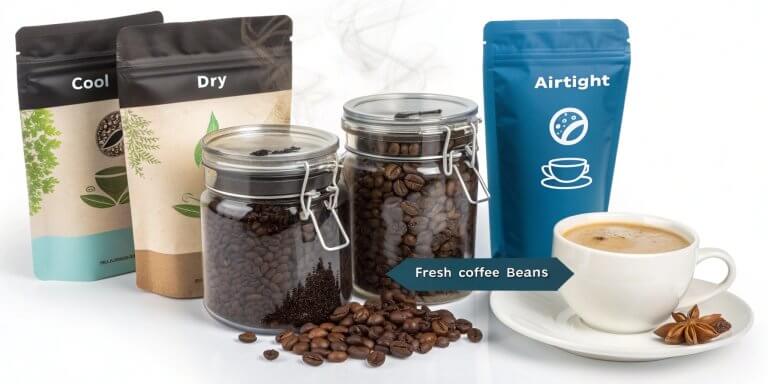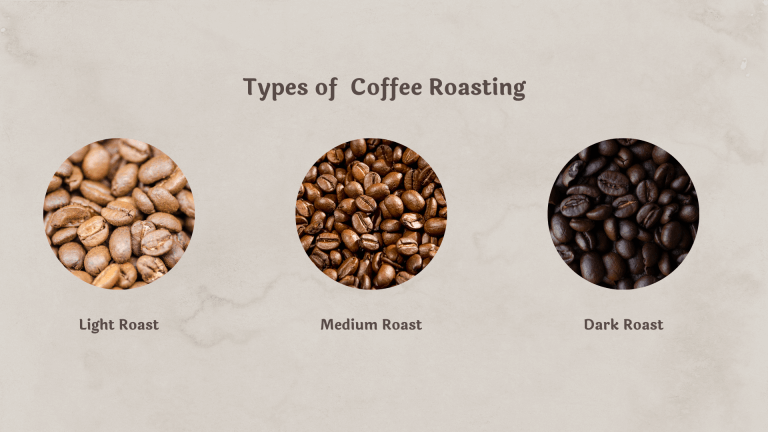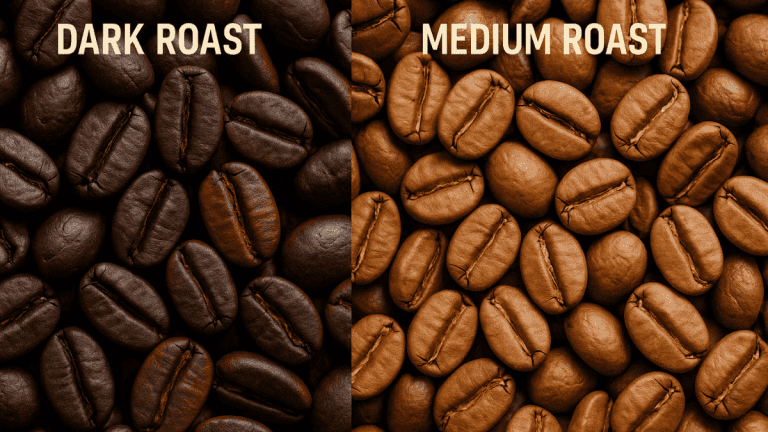
Coffee beans and espresso beans often get mixed up, but key differences affect how coffee tastes. Although they both start from the same green coffee bean, how they’re treated changes everything. Let’s explore what makes them unique, like roasting, grinding, flavor, and how they’re used.
What Exactly are Coffee Beans?
Picture from a coffee cherry. Inside are the versatile and diverse seeds we call coffee beans. These beans undergo a fascinating transformation through washing, drying, and roasting. The beauty of coffee beans lies in their adaptability to different growing conditions and roasting techniques, resulting in a wide range of flavors, from fruity to nutty, or even like chocolate.
Roasting is like cooking, and there are different levels. You can have light, medium, and dark roasts, each with its flavors. Once roasted, coffee beans can be used in many ways to make coffee, like in a drip coffee maker, French press, or cold brew.
Espresso Beans: The Concentrated Cousins
The roasting process is crucial in determining the flavor profile of the beans. For instance, espresso beans are roasted longer and at a higher temperature, which results in a more intense, concentrated flavor. This process is akin to making a reduction sauce—you cook it longer to intensify the flavor.
Like coffee beans, espresso beans can be Arabica, Robusta, or a mix. The goal is always to get a consistent, bold flavor perfect for an espresso shot. This is the kind of flavor you want when making lattes or cappuccinos.
Key Differences: Coffee Beans vs. Espresso Beans
Even though they start the same, coffee beans and espresso beans differ. Here’s a simple breakdown:
- Roast Level:
- Coffee beans can be roasted to different levels.
- Espresso beans are usually roasted to a dark or extra-dark level.
- Darker roasts used for espresso beans have less acidity and pronounced bitterness.
- Beans labeled as espresso are usually dark roast (sometimes medium roast), and if you buy them pre-ground, they will likely be a super fine grind.
- Brewing Method:
- With their versatility, coffee beans can be used in various brewing methods, from a drip coffee maker to a French press, cold brew, or pour-over. This diversity in usage opens up a world of flavors and experiences for coffee enthusiasts to explore, igniting a sense of adventure and excitement.
- Espresso beans are made for one thing: making espresso.
- An espresso machine uses pressure to force hot water through finely ground coffee beans.
- Flavor:
- Coffee beans offer a wide range of flavors.
- Espresso beans are all about delivering a consistent, bold flavor.
- Espresso beans bring out flavors like chocolate, nutty, and caramel.
How Roast Levels Change the Taste
The level of roasting changes how your coffee tastes. It’s like cooking – the longer you cook something, the different it tastes.
- Light Roasts:
- Bring out the fruity, floral, and acidic flavors.
- They suit mild coffee and brewing methods like pour-over or cold brew.
- Medium Roasts:
- Give you a balance of acidity, body, and flavor.
- These beans are suitable for many brewing styles, including strong brews.
- Dark Roasts:
- Emphasize rich, bold, and bitter flavors.
- They are often used for making espresso.
- Beans will have a shiny, oily surface and a dark brown color.
- Espresso Roasts:
- A dark roast taken to the next level.
- Roasted longer to reduce acidity and bring out a deeper, fuller body.
Grind Size: Why It Matters
The size of the grind is another thing that makes a big difference.
- Espresso Grind:
- Neat needs to be outstanding, but not too powdery.
- This helps pull out as much oil as possible during the short brewing time.
- Dark roast coffee beans (so, espresso beans) have more natural oils that give you that dark oily sheen.
- Coffee Grind:
- The grind size changes depending on how you’re making your coffee.
- Coarser is for a French press, and finer for pour-over or drip coffee.
The Role of Natural Oils
Natural oils affect the taste and feel of your coffee.
- Espresso Beans:
- They are rich in oil and have an oily sheen.
- These oils help create the crema, that foamy layer on top of an espresso, which is a sign of a well-made shot and adds to the overall flavor and texture of the drink.
- The emulsification of these oils helps create espresso crema.
- Coffee Beans:
- It may not have as much oil.
- You might not get a crema if you use them to make espresso.
Concentration and Taste: Finding the Right Balance
The concentration and taste are where espresso and coffee stand apart.
- Espresso Beans:
- Typically, they have a high concentration.
- They are dark roasted to work well in an espresso machine.
- The flavor of espresso beans is intense and concentrated, giving you a bold, unique taste with the brewing method. This intensity makes espresso a favorite for many coffee lovers, sparking intrigue and eagerness to experience its distinctive flavor.
- Has less acidity.
- Coffee Beans:
- Have a medium or balanced bitterness.
- They are roasted lightly to keep the full flavor.
- They are suitable for brewing methods that don’t use high pressure.
- Tends to be milder and sweeter.
- The main differences between espresso and coffee beans are the roasting time, grind size, caffeine content, natural oils, and best drink use. Understanding these differences will make you feel more knowledgeable and confident in your coffee choices.
Espresso vs. Coffee: Dispelling Myths and Sharing Facts
With so much information out there, it’s easy to get confused. Let’s clear up some common misconceptions and share some facts about coffee and espresso. By understanding these, you can make informed choices about your coffee preferences.
Myth: Espresso has more caffeine
- Reality: The roasting process burns away some of the caffeine, and the caffeine content remains the same whether a coffee is roasted dark or light.
- Espresso has a higher concentration of caffeine per ounce.
- A shot of espresso has a similar caffeine content to one cup of drip coffee.
- The caffeine content of espresso and coffee beans is relatively similar, but the brewing method affects the caffeine content of the final beverage.
Can I use coffee beans to make espresso?
- Fact: Yes, you can, but the taste and experience will differ.
- A lighter roast coffee may not extract as much flavor.
- The result may be less concentrated.
- The roast needs to be similar.
Espresso is a specific type of bean.
- Reality: It’s not a type of coffee bean but a dark roast technique used in preparing coffee beans to make a concentrated shot of coffee.
- Beans labeled as espresso are usually dark roast (sometimes medium roast), and if you buy them pre-ground, they will likely be a super fine grind.
How Many Cups of Coffee Can You Have?
- According to Science Alert, you shouldn’t drink more than four coffees, including espressos, in a day, as doing so may cause health issues.
- According to Science Alert, the recommended limit for coffee consumption is four cups a day, including espressos. This guideline is based on the potential health benefits of moderate coffee consumption, which may include a reduced risk of heart disease, especially for older adults.
Making the Right Choice
So, how do you pick between coffee beans and espresso beans? It all comes down to what you like.
- Choose coffee beans if:
- You want to make drip coffee, pour-over, cold brew, or French press.
- You want a coffee with a light, medium, dark, or extra-dark flavor.
- You want to try making espresso with different flavors.
- Choose espresso beans if:
- You love bold, full-bodied espresso shots.
- You have an espresso machine and want consistent results.
- You want to make drinks like lattes and cappuccinos. Consider the following factors when choosing the right beans:
- Flavor preference: If you prefer bold, robust flavors, opt for dark-roasted espresso beans. A lighter-roasted coffee bean might be better if you prefer milder flavors.
- Brewing method: Espresso beans are specifically designed for espresso machines and may not produce the best results in a regular drip coffee maker. Similarly, using coffee beans in an espresso machine may not achieve the desired result.
- Origin: The geographical location where the beans are grown can significantly impact their flavor. Beans from Central and South America often have brighter, fruity notes, while African and Asian beans can offer a more intense, earthy taste. Choose beans from your preferred region to cater to your taste buds.
- Blends vs. single-origin: Blends contain beans from multiple locations, creating a unique flavor profile that may be more balanced and versatile. Single-origin beans, in contrast, allow you to experience the pure taste of beans from a specific region.
It is essential to know that freshness is key. It’s always recommended to buy whole beans and grind them at home before brewing.
Final Thoughts
Coffee and espresso beans come from the same plant. What sets them apart is how they’re roasted and brewed. Espresso beans are roasted darker for a bolder taste, which is perfect for making espresso. Coffee beans come in different roast levels, each offering its flavors. The choice is yours, and it’s all about finding what you enjoy.

